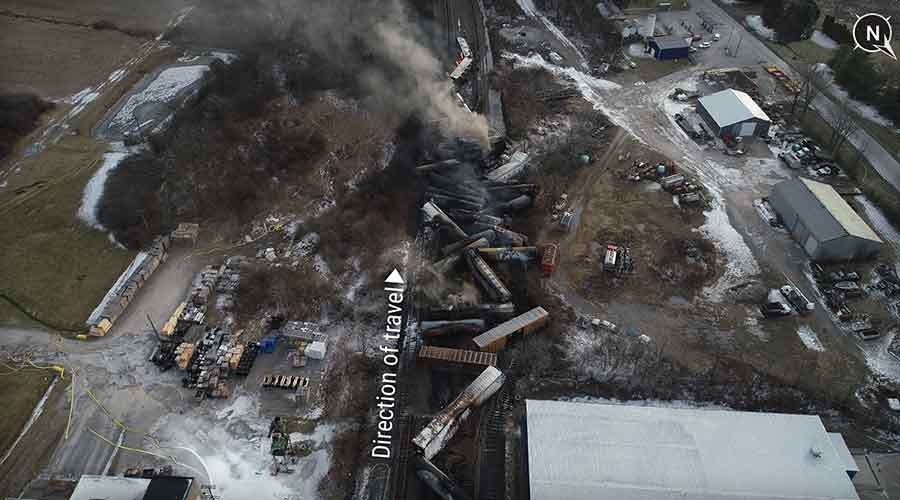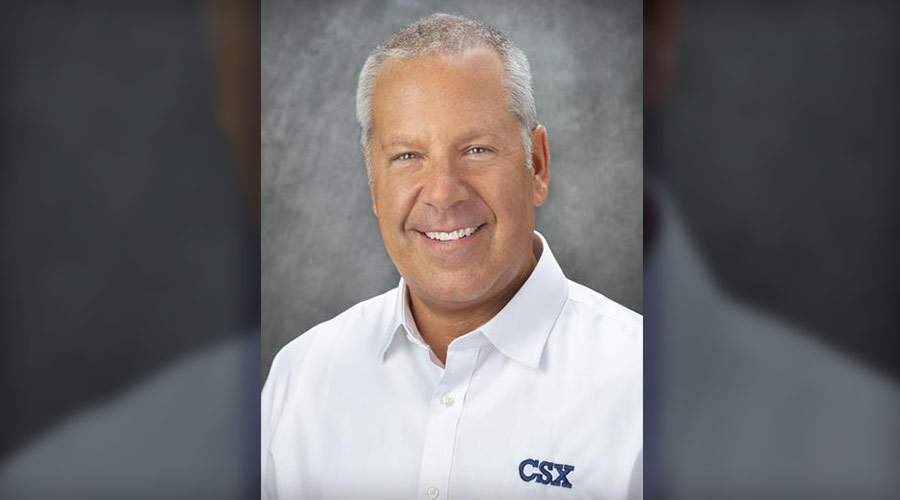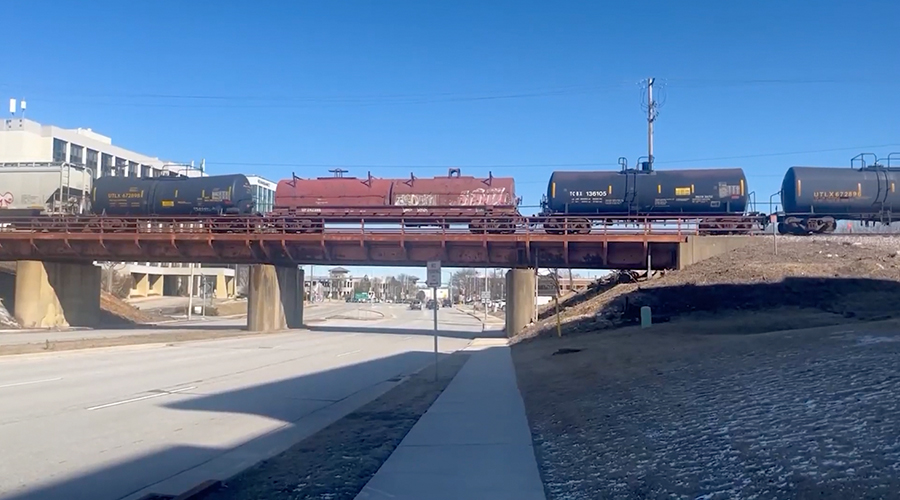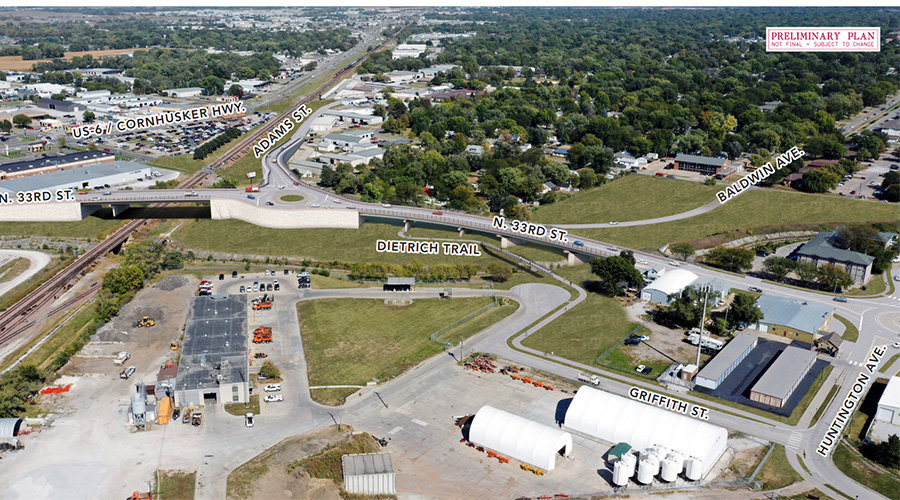Safety a major topic in Class Is' Q1 earnings reports
5/8/2023
By Julie Sneider, Senior Associate Editor
In their first-quarter 2023 reports to shareholders and analysts last month, Class I executives made a point early on to highlight what their companies are doing to improve rail transportation safety and how they’re measuring up on that quest.
No doubt their prominent placement of safety messaging was in response to the national public outcry over the Feb. 3 derailment in East Palestine, Ohio, of a Norfolk Southern Railway train carrying hazardous materials. Although the incident caused no fatalities or reported injuries, it did result in a major fire and prompted NS to conduct a controlled release of chemical fumes emanating from rail cars containing vinyl chloride.
NS continues to work with local, state and federal officials in cleaning up the derailment site, as well as pursue a plan to help the community recover by providing financial and other assistance to residents and businesses.
Since Feb. 3, NS President and CEO Alan Shaw has been called before U.S. House and Senate committees to testify about the accident, the company’s response and its safety practices. In the wake of the derailment, no fewer than six bills have been introduced in Congress to address what lawmakers say is lacking in railroad safety regulation and practice.
Meanwhile, the Federal Railroad Administration has issued safety advisories for railroads to examine hot-bearing wayside detectors and train length; and with the Pipeline and Hazardous Materials Safety Administration has announced a national initiative for focused inspections on routes that carry high-hazard flammable trains and other trains transporting large amounts of hazardous materials.
 “We're cleaning the [derailment] site safely, thoroughly and with urgency.” — Alan Shaw, Norfolk Southern Railway nscorp.com
“We're cleaning the [derailment] site safely, thoroughly and with urgency.” — Alan Shaw, Norfolk Southern Railway nscorp.com Safety issues related to the derailment were dominant topics during NS’ Q1 earnings report. The Class I’s income from operations fell 34% to $711 million, and diluted earnings per share declined 30% to $2.04 compared with first-quarter 2022. The results included an initial $387 million charge associated with the Feb. 3 derailment, although the results don’t reflect potentially recoverable amounts from insurance policies, NS officials said in a press release.
Shaw began the presentation by updating listeners to the company’s latest work in East Palestine.
“We're cleaning the site safely, thoroughly and with urgency. We're assisting families, supporting local businesses and nonprofits and investing in long-term projects for the area's future prosperity,” Shaw said, adding that he’s visited there nearly every week since the week after the derailment.
The company is not waiting for the National Transportation Safety Board to issue its final report before making safety improvements, such as installing additional safety sensors, speeding up deployment of advanced early detection technologies and increasing safety training for first responders, he said in an earnings call transcript.
Executive Vice President and Chief Operating Officer Paul Duncan further explained how NS is stepping up actions on the safety front, both in reducing train accidents and employee injuries.
“Specific steps we are taking to enhance safety after reviewing the NTSB's preliminary report on the East Palestine derailment [include] adding 200 more hot bearing detectors onto our network, expanding our network of acoustic bearing detectors and accelerating the deployment of digital train inspection portals, our most advanced safety technology,” Duncan said.
Following are selected quotes and statements from other Class I executives during Q1 2023 presentations:
CN
“The safety movement of all goods across North America has never been more front of mind,” said President and CEO Tracy Robinson. “This industry and our company have made tremendous progress on improving the safety of our operations over the past decades. And we’re all working toward reducing and ultimately eliminating harm: both incidents and injuries and ensuring that we protect our communities in which we operate and live.”
The rail industry has continued to invest in safety technology, leadership and culture, “but we’re not yet to zero as an industry,” she noted.
 “The safety movement of all goods across North America has never been more front of mind.” — Tracy Robinson, CN cn.ca
“The safety movement of all goods across North America has never been more front of mind.” — Tracy Robinson, CN cn.ca “After the derailment in Ohio earlier this year, all the Class Is convened, put all our respective technology, protocols and wayside detectors on the table and we together used that to develop new voluntary standards for our industry and wayside detection. And each of us is in the process of implementing those standards,” Robinson said.
Federal regulators should be “positive” partners in the effort, but they should take a “fact-based, data-driven approach that connects potential solutions with root causes,” she added.
CN’s injury frequency rate declined 17% and the train accident rate fell 41% YOY in Q1, said Executive Vice President and Chief Operating Officer Ed Harris.
Canadian Pacific Kansas City
“On the safety front, I'm proud that the team's built on last year's record safety performance, continuing a strong performance in the first quarter with FRA personal injuries down 10% and train accidents down an additional 6%,” said President and CEO Keith Creel. “Running a safe and reliable railroad is the key ingredient to what successfully running a [precision scheduled railroad] operating model is all about and it's something that we take tremendous pride in. It's CP and now, CPKC.”
CSX Corp.
“The statistics are clear: When measured by the number of accidents or injuries relative to the enormous number of ton-miles that our trains travel, freight railroads are very safe when compared to other forms of transportation,” said President and CEO Joe Hinrichs. “We are very proud of our excellent safety record at CSX. But we know that we cannot be complacent.”
Executive Vice President of Operations Jamie Boychuk told analysts that this year the railroad is installing 53 additional hotbox detectors across its network reduce the average spacing between them from 16.2 miles to 14.9 miles.
 “We are very proud of our excellent safety record at CSX. But we know that we cannot be complacent.” — Joe Hinrichs, CSX csx.com
“We are very proud of our excellent safety record at CSX. But we know that we cannot be complacent.” — Joe Hinrichs, CSX csx.com “These detectors identify high bearing temperatures but also transmit real time data for trend analysis. So, we not only can tell when a bearing is hot and a train needs to stop, but we can also use the data to predict bearings and issues before they reach critical temperatures,” Boychuk said.
In addition, CSX: educates new employees on the company’s safety culture as part of their training at the CSX Railroad Education and Development Institute in Atlanta; uses autonomous track assessment cars on trains to gather safety inspection data used to monitor track conditions; and educates first responders in communities across the network how to respond to a train derailment.
Boychuk acknowledged both CSX’s personal injury frequency index and train accident rate (based on FRA criteria) ticked up year over year in Q1.
“It's important to consider that because of the success of our recent hiring efforts, we have a higher percentage of newer employees; as they gain experience and learn from fellow railroaders, we’re confident that the frequency of these incidents will decline,” he said.
Union Pacific Railroad
“We continue to make great strides on safety, as evidenced by our 10% improvement on derailment performance in the first quarter,” said Executive Vice President of Operations Eric Gehringer. “While the progress on safety is encouraging, our goal remains a future with zero incidents with injuries.”
To get there, UP has implemented state-of-the-art technology, including Precision Train Builder; a track geometry inspection fleet; more than 7,000 wayside detection devices; and a 24/7 operating command center, Gehringer said.
He also referenced the industry’s announced safety actions in March, which included enhanced standards for how to proactively use and share critical data.
“The railroad industry remains one of the safest transportation modes in the nation,” Gehringer said. “And through our capital renewal program, Union Pacific invests almost $2 billion annually into its network to further improve safety.”


